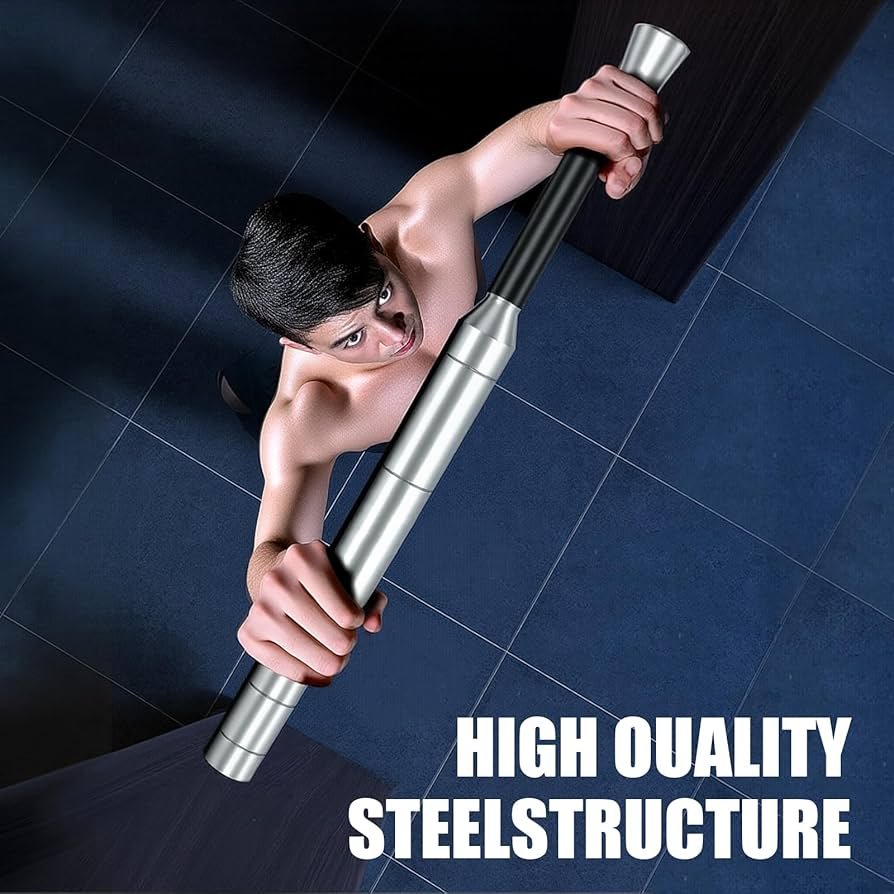Have you ever wondered if there’s a different way to build strength without the heavy clanging of traditional weights? Macebell training is gaining attention as a powerful alternative, promising to challenge your muscles in new ways.
But can it truly replace the classic weightlifting routines you know? If you want to discover how this ancient tool might transform your workouts and whether it fits your fitness goals, keep reading. Your next breakthrough could be just a swing away.

Macebell Basics
Macebell training uses a special weighted club. It helps build strength and improve grip.
This training is different from lifting weights with dumbbells or barbells. It focuses on swinging and moving the macebell in many ways.
What Is A Macebell
A macebell is a long handle with a heavy ball at one end. It looks like a medieval weapon called a mace.
People use it for exercise by swinging, pressing, and holding it. This trains muscles, joints, and coordination.
History And Origins
The macebell comes from ancient weapons used by warriors. They trained with heavy clubs to get stronger.
Today, the macebell is a fitness tool that keeps these old traditions alive. It mixes strength and movement training.
Types And Sizes
Macebells come in different weights and sizes. Beginners start with lighter ones. Advanced users pick heavier macebells.
- Light macebells weigh about 5 to 10 pounds
- Medium macebells weigh about 15 to 20 pounds
- Heavy macebells weigh 25 pounds or more
- Length varies from 18 to 36 inches

Benefits Of Macebell Training
Macebell training uses a weighted club with a long handle. It challenges your muscles in new ways. This training helps build strength, balance, and mobility.
Many people ask if macebell training can replace traditional weightlifting. It offers unique benefits that complement regular workouts.
Improved Grip And Forearm Strength
Macebell training forces your hands and forearms to work hard. The uneven weight makes you hold the mace firmly. This builds strong grip and forearm muscles.
Strong grip helps in many sports and daily activities. It also improves your ability to lift heavier weights safely.
- Builds wrist and forearm muscles
- Improves hand endurance
- Enhances ability to hold heavy objects
Enhanced Shoulder Mobility
Using a macebell involves swinging and rotating movements. These moves increase shoulder joint flexibility. This helps your shoulders move more freely.
Better shoulder mobility lowers the risk of injuries. It also helps with overhead lifts and other exercises.
- Increases range of motion
- Strengthens shoulder stabilizers
- Reduces stiffness and pain
Core Stability And Balance
Macebell exercises require you to keep your body stable. The shifting weight challenges your core muscles. This improves your balance and control.
A strong core supports your spine and posture. It helps you perform other exercises better and safely.
- Strengthens abdominal and lower back muscles
- Improves body coordination
- Enhances overall balance
Functional Strength Gains
Macebell training mimics real-life movements. It trains muscles to work together. This improves your ability to do everyday tasks.
Functional strength helps with lifting, carrying, and twisting actions. It makes your body strong and ready for different challenges.
- Builds strength for daily activities
- Improves muscle coordination
- Prepares body for natural movements
Traditional Weightlifting Strengths
Traditional weightlifting uses free weights and machines to build strength. It focuses on lifting heavy weights with good form. This method helps improve muscle size and power over time.
Many people trust traditional weightlifting because it offers clear ways to track progress. It has been studied for decades and shows solid results in strength training.
Muscle Hypertrophy
Traditional weightlifting causes muscles to grow larger by stressing muscle fibers. This process is called muscle hypertrophy. It happens when muscles repair after being worked hard.
By using different weights and exercises, you can target many muscle groups. This variety helps build bigger and stronger muscles all over the body.
Maximal Strength Development
Traditional weightlifting helps increase the maximum force your muscles can produce. Lifting heavy weights trains your nervous system to activate more muscle fibers. This leads to greater strength.
Exercises like squats, deadlifts, and bench presses focus on improving your raw strength. These moves train your body to handle heavy loads safely and efficiently.
Structured Progressive Overload
Progressive overload means gradually increasing the weight or reps over time. Traditional weightlifting uses this principle to help muscles grow and get stronger.
This structure lets you track progress clearly. You can add small weights or do more reps each session. This steady increase challenges your muscles and avoids plateaus.
- Increase weight lifted
- Increase number of repetitions
- Increase number of sets
- Decrease rest time between sets
Comparing Training Effects
Macebell training and traditional weightlifting offer different benefits. Each method works muscles and joints in unique ways.
Understanding these differences helps you choose the best training style for your goals.
Muscle Groups Targeted
Traditional weightlifting focuses on isolated muscle groups. You can target specific muscles like biceps, chest, or legs.
Macebell training works many muscles at once. It uses swinging and rotational moves that engage the core, shoulders, and arms.
- Weightlifting: isolates muscles like quads, chest, and biceps
- Macebell: activates core, shoulders, back, and grip muscles
- Macebell also improves muscle coordination
Joint Impact And Safety
Weightlifting puts steady pressure on joints with controlled lifts. This can strain joints if form is poor or weights are too heavy.
Macebell training uses dynamic, swinging motions. It may reduce joint stress by promoting natural movement patterns and flexibility.
- Weightlifting: higher joint load with heavy weights
- Macebell: dynamic motions may lower joint strain
- Both require good technique to avoid injury
Versatility And Movement Patterns
Weightlifting focuses on linear, controlled moves like presses and squats. It builds strength in fixed patterns.
Macebell training uses varied, multi-directional swings. This improves balance, coordination, and functional strength.
- Weightlifting: limited to set movement paths
- Macebell: encourages fluid and full-body motions
- Macebell enhances joint mobility and balance
Combining Both Methods
Macebell training and traditional weightlifting each have unique strengths. Using both can improve overall fitness and strength.
Combining these methods helps balance muscle growth, endurance, and mobility for better results.
Complementary Benefits
Macebell training improves grip, core strength, and rotational power. Weightlifting builds muscle size and pure strength.
Using both leads to a well-rounded body that performs well in many activities and sports.
- Macebell training boosts joint stability and coordination
- Weightlifting increases maximum strength and muscle mass
- Both improve endurance and work capacity
Sample Hybrid Workouts
Mixing macebell and weightlifting exercises in one session can save time and enhance fitness.
Try combining swinging macebell moves with classic lifts like squats or deadlifts.
- Warm-up: 5 minutes of macebell swings and circles
- Weightlifting: 3 sets of squats or deadlifts
- Macebell: 3 sets of 10 overhead or side swings
- Weightlifting: 3 sets of bench press or rows
- Cool down: light macebell moves and stretching
Injury Prevention Strategies
Using both training styles helps reduce injury risk by balancing muscle groups and movement patterns.
Proper warm-up, form, and recovery are important to stay safe while training.
- Warm up with light macebell swings and joint rotations
- Focus on correct lifting technique for all exercises
- Alternate training days between macebell and weightlifting
- Rest and stretch to prevent tight muscles and overuse
- Listen to your body and reduce load if needed
Choosing The Right Approach
Deciding between macebell training and traditional weightlifting depends on your needs. Both offer benefits but suit different goals and preferences.
Understanding which method fits you helps avoid injury and reach fitness goals faster. Consider your situation before choosing.
Fitness Goals Alignment
Macebell training focuses on functional strength, mobility, and core stability. It improves coordination and endurance.
Traditional weightlifting builds muscle size, maximal strength, and power. It targets specific muscle groups effectively.
- Choose macebell for full-body conditioning and joint health.
- Choose weightlifting for muscle growth and heavy strength.
Experience And Skill Level
Macebell training requires good technique and body control. Beginners may need guidance to avoid injury.
Weightlifting also needs proper form but often starts with simple lifts. Coaches can help beginners learn safely.
- New exercisers should focus on learning form first.
- Intermediate and advanced users can explore macebell moves.
Accessibility And Equipment
Macebells are compact and easy to use at home or outdoors. They need less space than weightlifting setups.
Weightlifting requires access to barbells, plates, or machines. Gym membership or a home gym is often needed.
- Macebells suit those with limited space or budget.
- Weightlifting suits those with gym access or equipment at home.

Frequently Asked Questions
Can Macebell Training Build Muscle Like Weightlifting?
Macebell training improves strength and muscle endurance. However, traditional weightlifting is more effective for maximum muscle growth and hypertrophy due to heavier loads and varied exercises.
Is Macebell Training Safer Than Traditional Weightlifting?
Macebell training offers dynamic movement and joint mobility benefits. It can reduce injury risk but requires proper technique. Weightlifting safety depends on form and supervision.
Can Macebell Replace Weights For Full-body Workouts?
Macebells engage multiple muscle groups and improve functional strength. However, for balanced full-body development, combining both macebell and traditional weights is ideal.
How Does Macebell Training Affect Grip Strength?
Macebell workouts significantly enhance grip strength due to thick handles and swinging motions. This benefit often surpasses that of traditional weightlifting.
Conclusion
Macebell training offers unique benefits compared to traditional weightlifting. It improves grip strength and enhances mobility. This type of training engages multiple muscle groups. Perfect for those seeking variety in workouts. While it can’t fully replace weightlifting, it complements it well.
Both methods have their own strengths and benefits. Consider your goals and preferences. Choose what suits your fitness journey best. Mixing both can yield balanced results. Ultimately, your choice depends on personal needs. Prioritize what keeps you motivated and consistent.
Embrace the variety for a well-rounded fitness routine.



